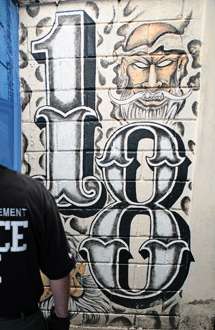18th Street gang
 18th Street Gang Graffiti | |
| Founded | 1960s[1][2] |
|---|---|
| Founding location | Los Angeles, California |
| Years active | 1960s – present[1] |
| Territory | Central America, Mexico, United States and Canada[3] |
| Ethnicity | Mainly Mexicans, Salvadorans, Hondurans, Guatemalans and other Latin Americans |
| Membership (est.) | 30,000 - 50,000 in the United states[3] |
| Criminal activities | Drug trafficking, assault, arson, robbery, kidnapping, pandering, money laundering, extortion, arms trafficking, human trafficking, theft, murder, racketeering and fraud |
| Allies | Mexican Mafia |
| Rivals |
Mara Salvatrucha Norteños Bloods Crips (certain sets) The Avenues Compton Varrio Largo 36 |
18th Street, also known as Calle 18, Barrio 18, Mara 18, or simply La 18 in Central America,[1][4][5][6] is a multi-ethnic (largely Central American and Mexican) transnational criminal organization that started as a street gang in Los Angeles. It is one of the largest transnational criminal gangs in Los Angeles, with 30,000 to 50,000 of members in 20 states across the US alone and is also allied with the Mexican Mafia.[7] As listed in the Justice Department Report about 18th street and MS-13, "These two gangs have turned the Central American northern triangle into the area with the highest homicide rate in the world."[8]
History
18th Street gang started near 18th Street and Union Avenue in the Rampart District of Los Angeles.[1] There is conflicting information as to the exact area, but this is a generally accepted area by most academic sources. They were originally part of Clanton 14 but wanted to make a separate "clique" called Clanton 18th Street and allow immigrants the opportunity to join. This proposal was rejected by the Clanton 14, which led to the formation of the 18th Street gang. The two gangs have been bitter rivals ever since.[9]
The 18th Street gang grew by expanding its membership to other nationalities and races, and it was among the first multiracial, multi-ethnic gangs in Los Angeles.[1] In the beginning, they were made up largely of second-generation Hispanics.[1] As the 18th Street gang began to battle with more established Hispanic gangs, they began to recruit outside the Hispanic community. There are approximately 200 separate individual autonomous gangs operating under the same name within separate barrios in the San Fernando Valley, the San Gabriel Valley, South Bay, Riverside, East Los Angeles, South Los Angeles, Downtown Los Angeles, Pico Union, Inglewood, Lynwood, South Gate, Huntington Park, Maywood, Long Beach, Orange County, and Los Angeles' Westside, according to the latest figures from the NDIC. In the early 2000s, the Federal Bureau of Investigation initiated wide-scale raids against known and suspected gang members, netting hundreds of arrests across the country.
Central America
Although it started as a Mexican gang, 18th Street quickly became mainly Central American as it started to recruit more members of other ethnic groups.[10][11][12][13] When Central American gang members were arrested in the United States, they were then deported back to Central America where the gang rose out-of-control on different levels of violence not just in El Salvador, but in Honduras and Guatemala as well, becoming one of the most violent gangs in Central America.[14][15][16][17] 18th Street later became a bitter rival of MS-13 as both gangs wanted the top spot in Central America. Members of 18th street are mainly Salvadoran, Guatemalan, and Honduran, but the gang does have members from other parts of Central America. 18th Street influences have recently been spotted in Belize as well.[18][19][20][21]
In El Salvador a faction called the "Revolucionarios" ("Revolutionaries") split off 18th Street in 2005,[3][22] becoming rivals with the remaining members, who came to be known as the "Sureños".[23][24][25][26]
Location
The majority of 18th Street cliques operate throughout Southern California, but are active in other states and internationally as well. Los Angeles members began migrating to other areas outside America and started to establish their own cliques. 18th Street cliques have been identified in 120 cities in 37 states and the District of Columbia in the United States, as well internationally in Spain, Australia, Canada, England, France, Germany, Lebanon, Peru, Philippines, Chile, Ecuador, Mexico, Guatemala, Honduras, and El Salvador.[27]
Culture
18th Street gang members are required to abide by a strict set of rules. Failure to obey the word of a gang leader, or to show proper respect to a fellow gang member, may result in an 18-second beating, or even execution for more serious offenses.[28] According to the FBI, some factions of the 18th Street gang have developed a high level of sophistication and organization. 18th Street gang members often identify themselves with the number 18 on their clothing and sporting clothing from sports teams such as the Duke Blue Devils, Los Angeles Clippers, Los Angeles Angels, Los Angeles Chargers, Los Angeles Dodgers, Los Angeles Lakers and Oakland Raiders. 18th Street will use the symbols XV3, XVIII, X8, 99 (9+9=18), and 3-dots in their graffiti and tattoos. 18th Street colors are blue and black; blue is to represent and to pay tribute to The Mexican Mafia, and black is to represent the original color for the gang. The 18th Street gang is occasionally referred to as the "Children's Army" because of its recruitment of elementary and middle-school aged youth. They also allow other races to join their ranks making the gang Multi-ethnic. In El Salvador it is common for members of the gang to be tattooed on the face with a large "18". In many cases the tattoo covers the entire face.[29]
Criminal activity

"We recognize them as one of the most violent street gangs and one of the most prolific in the United States," says Special agent George Rodriguez, who until his retirement oversaw investigations for the federal Bureau of Alcohol, Tobacco, Firearms and Explosives. Cars are stolen and homes are burglarized by the gang routinely. On average, someone in Los Angeles County is assaulted or robbed by 18th Streeters every day. The gang has left a bloody trail at a pace three times that of many of the city's most active gangs. 18th Street is a well established gang that is involved in all areas of street-crime. Some members have even become involved in producing fraudulent Immigration and Customs Enforcement identification cards and food stamps. Several 18th Street gang members have reached a higher level of sophistication and organization in their illicit activities than other gangs. While their main source of income is street-level distribution of drugs, they also have been linked to murders, assaults, arson, copyright infringement, extortion, human trafficking, illegal immigration, kidnapping, prostitution, robbery, and weapons trafficking, as well as other crimes.[30] 18th Street Gang has also been implicated in the high-profile kidnapping and murder of the 16-year-old brother of internationally renowned Honduran football player Wilson Palacios.[31]
In 1998, Catarino Gonzalez was sentenced to life in prison after a jury convicted Gonzalez of first-degree murder for fatally shooting Officer Filbert Cuesta in the back of the head, while the Officer was sitting in a patrol car.[32][33]
See also
References
- 1 2 3 4 5 6 Ribando, C. (2005). "Gangs in Central America" (PDF). U.S. Department of States, Foreign Affairs, Defense, and Trade Division.
- ↑ Morales, G. (2007). "18th Street". gangpreventionservices.org. Archived from the original on 17 January 2009.
- 1 2 3 "Barrio 18". www.insightcrime.org. Retrieved 2017-06-21.
- ↑ Lynch, T. W. (2008). "The evolution of modern Central American street gangs and the political violence they present: Case studies of Guatemala, El Salvador and Honduras". Theses and Dissertations". p. 370.
- ↑ "HSI dismantles '18th street' gang's fraudulent document ring". U.S. Department of Homeland Security, U.S. Immigration and Customs Enforcement. 2011.
- ↑ Berlin, D.; Brizius, E.; Bump, M.; Garshelis, D.; Khonsari, N.; Pinheiro, E.; Rhudy, K.; Smith, J. (2007). "Between the border and the street: A comparative look at gang reduction policies and migration in the United States and Guatemala. Informally published manuscript, Georgetown University Law Center, Human Rights Institute, Georgetown University, Washington D.C., USA".
- ↑ "Barrio 18: Meet the terrifying gang so violent it rivals MS-13". Mail Online. Retrieved 2018-01-29.
- ↑ O'Reilly, Andrew (2017-08-04). "MS-13 isn't the only homicidal street gang in town - meet Barrio 18". Fox News. Retrieved 2018-01-29.
- ↑ Zilberg, E. (2011). Space of detention: The making of a transnational gang crisis between Los Angeles and San Salvador. Durham, NC: Duke University Press.
- ↑ Maras in Guatemala Increasing in Sophistication - published by Jeremy McDermott on 3 January 2013
- ↑ "El Salvador's horrifying culture of gangs". By Associated Press. Retrieved 29 December 2014.
- ↑ Julie Suarez. "Gangs in Guatemala" (PDF). By ghrc-usa.org. Archived (PDF) from the original on 1 January 2015. Retrieved 29 December 2014.
- ↑ "Guatemalan gang culture conquers the abused with abuse". Marc Lacey. Retrieved 29 December 2014.
- ↑ "El Salvador organized crime". insightcrime.org. Archived from the original on 1 January 2015. Retrieved 29 December 2014.
- ↑ "Honduran gangs Salvatrucha and 18th Street announce truce". insightcrime.org. Retrieved 29 December 2014.
- ↑ "Honduran Street gangs". worldbulletin.net. Archived from the original on 1 January 2015. Retrieved 29 December 2014.
- ↑ Honduras gangs "You can recognise the gangs from their murders" published By Rob Crilly on 14 November 2014
- ↑ Honduran 18th Street gang member arrested in Belize publish by edition.channel5belize.com
- ↑ "The evolution of modern Central American street gangs". Tristam W. Lynch. Archived from the original on 1 January 2015. Retrieved 29 December 2014.
- ↑ "Central American Gangs, Made in L.A." Marlon Bishop. Archived from the original on 1 January 2015. Retrieved 29 December 2014.
- ↑ "Gangs in Central America" (PDF). Clare Ribando. Retrieved 29 December 2014.
- ↑ "The 18th Street Gang Just Set Out to Prove It Runs El Salvador's Transport System - VICE News".
- ↑ "La Revolución en Mariona".
- ↑ Partlow, Joshua (3 April 2016). "Two Salvadoran gangsters walk into a church" – via www.washingtonpost.com.
- ↑ "Rivers of blood". The Economist.
- ↑ "MS-13 y mara 18 planean unirse para enfrentar al Estado". elsalvador.com (in Spanish). April 20, 2015.
- ↑ Bruneau, Thomas (1 December 2011). Maras: Gang Violence and Security in Central America (Google eBook). University of Texas Press. p. 37. ISBN 978-0-292-72928-5. Retrieved 3 March 2014.
- ↑ Pollack, Ricardo (January 24, 2005). "Americas | Gang life tempts Salvador teens". BBC News. Archived from the original on 12 August 2010. Retrieved August 9, 2010.
- ↑ Ruck, Joanna. "El Salvador gangs celebrate a day without murders - in pictures". The Guardian. Retrieved 22 August 2016.
- ↑ National Gang Intelligence Center – National Gang threat assessment 2009 Archived 14 December 2011 at the Wayback Machine.
- ↑ Willie Gannon (May 10, 2009). "Tottenham's Wilson Palacios' Brother Murdered By Kidnappers in Honduras". Bleacher Report. Archived from the original on 16 January 2015. Retrieved August 9, 2010.
- ↑ Life Term Given in Slaying of Officer published by TIMES STAFF WRITER
- ↑ People v. Gonzalez published by scocal.stanford.edu
Further reading
- BBC News: El Salvador swoops on street gang
- PBS Wide Angle: 18 With a Bullet 18th Street Gang in El Salvador
External links
| Wikimedia Commons has media related to 18th Street Gang. |
- MS-13 Member’s Trail Shows Gang’s Movement 18th Street Gang/MS-13 Rivalry
- Strohm, Chris (1 August 2005). "DHS touts success of anti-gang operation". GovExec.com. Archived from the original on 3 March 2006. Retrieved 14 March 2006.
- La Cloaca Internacional: Entrevista de dos horas a integrantes del Barrio 18 (in Spanish)
- FBI.gov
- ICE.gov